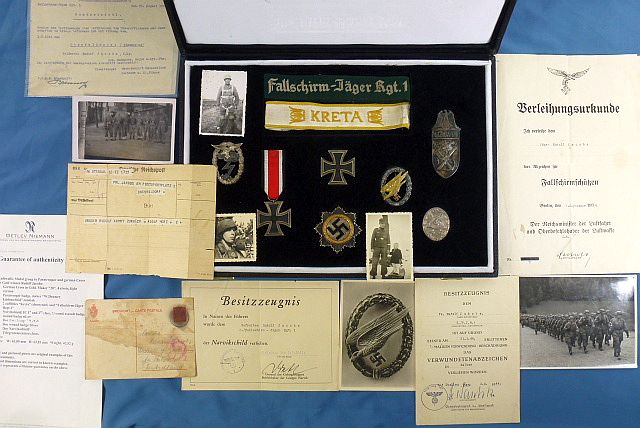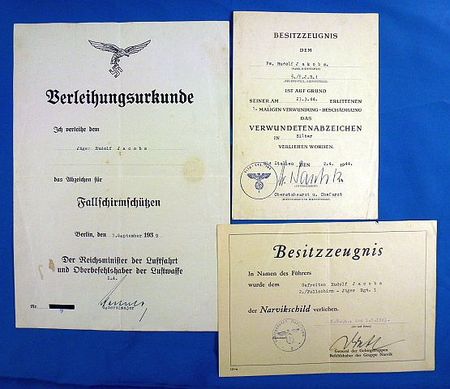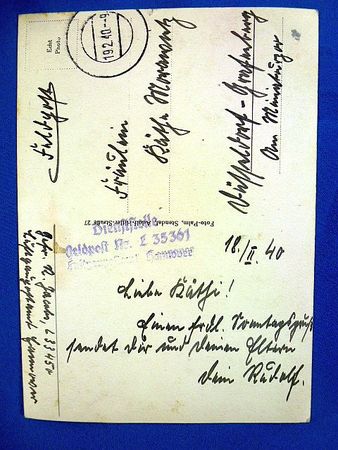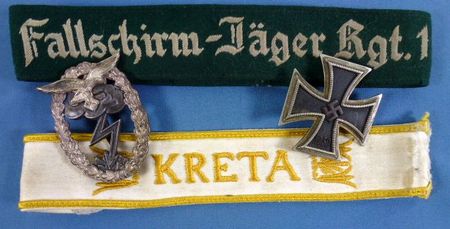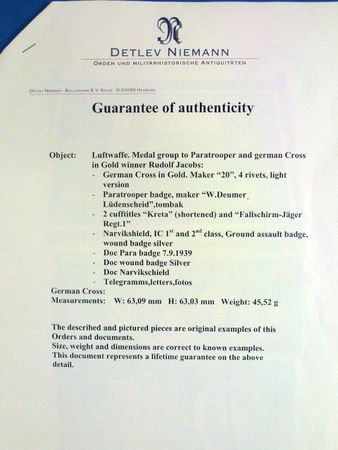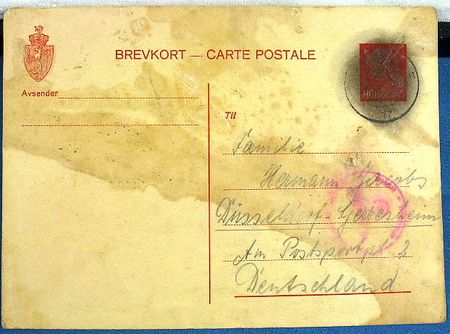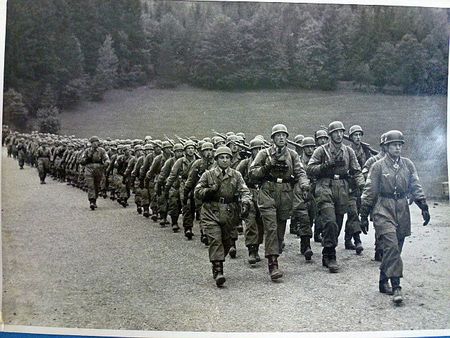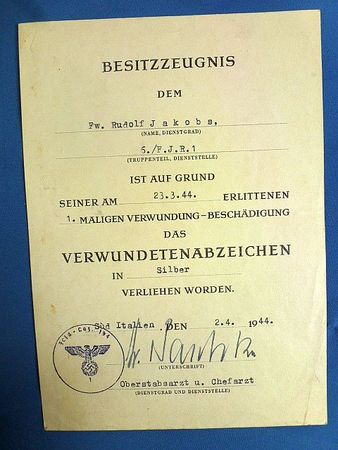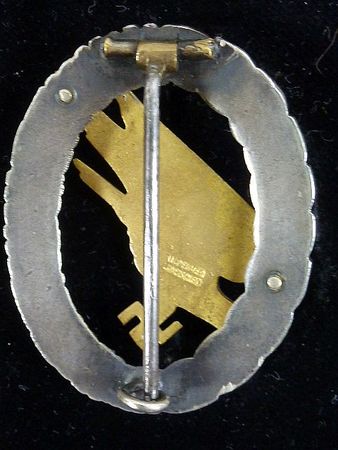Identified German Paratrooper Medals, Documents Group
$9,000.00
An exceptional World War II grouping comprised of the medals, documents, insignia and photographs of paratrooper Rudolf Jacobs, who served in Faschirmjaeger Regiment 1 during the war. The 1st Fallschirmjaeger Regiment fought in Poland, Denmark, Norway, Holland and Russian until 1943, when it then became a part of the 1st Fallschirmjaeger Division. That Division saw action in the defense of Sicily and then on the Italian mainland. The paratroopers of the 1st Division earned the name of “The Green Devils of Cassino” for their actions tenacious defense in the Battle of Monte Cassino. The group is accompanied by a Certificate of Authenticity from the noted German militaria dealer Detlev Niemann and it is comprised of the following items:
Medals and Decorations:
– German Cross in Gold, marked with the Prasidialkanzlei number “20”, reflecting manufacture by the firm of C.F. Zimmermann. The cross is four rivet construction and is the lighter weight version of the decoration by Zimmermann. Jacobs was awarded the German Cross in gold on October 1, 1944, for action against American and British forces in Italy.
– Fallschirmjaeger badge, a superb early example in Tombak, maker marked by the firm of Wilhelm Deumer.
– 1939 Iron Cross, 1st Class.
– 1939 Iron Cross, 2nd Class.
– Luftwaffe Ground Assault badge, a fine example, two piece riveted construction.
– Wound Badge in silver.
– Narvik Campaign shield. The shield has no backing cloth and is lacking the two upper attachment prongs on the reverse.
Insignia:
– “Fallschirmjaeger Regiment 1” cuff title, full length, machine embroidered in silver-gray thread on green wool.
– “Kreta” cuff title, shortened, about 9 inches in length.
All of the medals, decorations, and insignia are contained within a custom made black leather case. The lower section of the case is lined in black velvet and has recessed, fitted compartments to hold the decorations and the cuff titles.
Award Documents:
-The large award document for the Faschirmjaeger badge, 8 1/4 by 11 1/2 inches, dated 7 September, 1939, and named to “Jaeger Rudolf Jacobs”.
– Award document for the Narvik shield, dated March 1, 1941, and named to “Gefreiter Rudolf Jacobs” of “2./Fallschirm-Jaeger Rgt. 1”. The document is 5 3/4 by 8 1/4 inches in size.
– Award document for the Wound Badge in Silver, named to “Fw. Rudolf Jakobs” of “6./F.J.R. 1”, and dated April 2, 1944 in southern Italy, with the date of the wound having been March 23, 1944. The date of Jacobs’ wound corresponds to the combat that was taking place at Monte Cassino.
Personal Photos and Other Documents
– The group includes a larger photograph, about 5 inches by 7 inches in size. The photograph shows a column of German paratroopers on the march, wearing fallschirmjaeger helmets and paratrooper smocks. The officer leading the column wears the Knights Cross of the Iron Cross. On the back of the photograph is the original autograph “Ramke”, this being the signature of General Hermann-Bernhard Ramcke, a commander of German paratroopers during the war whose decorations included the Knights Cross of the Iron Cross with Oak Leaves, Swords, and Diamonds, with Ramke being one of only 27 recipients of that decoration. Ramke was the designated commander of “Fortress Brest” in France when it was surrounded by American forces during the battle for Normandy. Brest ultimately surrendered in September of 1944 and Ramke was among the prisoners. He survived the war, living until 1968, and he attended various reunions of German soldiers, particularly veteran paratrooper. The photograph was likely signed for Rudolf Jacobs by Ramke at one of these post-war reunions.
– The group includes three small photographs of Rudolf Jacobs. In one photo he hold the hand of a small child and on hs uniform tunic can be clearly seen the “Kreta” cuff title, the Iron Cross, 1st Class, the Luftwaffe Ground Assault badge, the wound badge, and the Fallschirmjaeger badge. The wound badge appears to be the black version, so the photograph was probably taken before the spring of 1944 when Jacobs was wounded again in Italy and awarded the wound badge in silver. Another small photo shows Jacobs wearing a solid color paratrooper smock, paratrooper helmet, and parachute harness. There is a written notation on the back which includes the date of June 24, 1943. The third photograph is a head and shoulders image which shows Jacobs wearing a camouflage paratrooper smock, a paratrooper helmet with camouflage cover, and with an MG 34 machine gun resting on his shoulder, the photo clearly showing the barrel, the removable drum belt ammunition container, and the double crescent trigger.
– Photo postcard of a group of 8 Luftwaffe enlisted personnel. There is a handwritten note on the back from Rudolf Jacobs which is dated May 13, 1940.
– Large postcard of a Fallschirmjaeger badge, which was mailed by Jacobs to a fraulein on February 19 of 1940. there is a handwritten note on the postcard from Jacobs to the woman. The postcard clearly bears the official stamp of “Dienststelle Feldpost 35361”, or Military Field Postal Station number 35361. In 1940 the field post number 35361 was used by Fallschirmjaeger Regiment 1.
– A Norwegian postcard sent to the “Family of Hermann Jacobs” (presumably this was Rudolf Jacobs’ father) in Dusseldorf. The postcard has a typed message on the reverse and then it is signed by Jacobs. The message, typed in German, reads “I am in Norwegian captivity and in good health. Please also tell ____.” . In the blan space provided Jacobs wrote in the name of someone (a sweetheart?) with whom he wanted his family to convey the news that he had been taken prisoner. There is a postmark on the postcard, but the postcard apparently became wet in the mail and the date on the postmark is not legible. Jacobs’ captivity was undoubtedly brief. The invasion of Norway began on April 9, 1940 and ended almost exactly two months later, and the material in the group establish that Jacobs was a participant in the battle for Narvik. As such, he would not have been a prisoner of war for very long, but it was obviously long enough for the Norwegians to have had him complete this postcard.
– There is a telegram, still with its original Third Reich envelope, that was sent to “Frau Jakobs” in Dusseldorf on May 12 of 1940 by an Adolf herz. The message, in German, reads simply “Brother Rudolf has come back”. This telegram apparently advised Jacobs’ mother that her son Rudolf had been freed from Norwegian captivity and had returned to German military authorities or perhaps even to Germany itself.
– A document dated August 20, 1944, issued to Jacobs by Fallschirmjaeger Regiment 1 and confirming that he had been promoted from the rank of Feldwebel (an American Technical or Staff Sergeant) to the rank of Oberfeldwebel (An American Master Sergeant or Warrant Officer), with the effective date of the promotion as August 1, 1944.
A remarkable group that belonged to a highly decorated member of one of Germany’s elite military units in World War II.
Sold!

